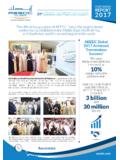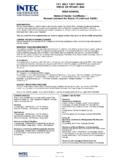Transcription of Check the DHET website for registered providers
1 Institutions, the sector ranges from those providers The changing landscape of that operate on a non-profit basis to those that are private higher education enterprise-driven. There are some that charge low fees, while others charge fees that are higher for the same courses than at the public institutions. With the entrance of many new players in the south Check the DHET. africa private higher education market, both local and international, the landscape in terms of size and shape is changing rapidly.
2 This monitoring brief provides an overview of five current trends and website for registered suggests potential future developments in private higher education . providers The sector has periodically changed size and shape according to various factors. In the immediate post- Introduction apartheid period, there was a sudden influx of While some of the public universities in south africa foreign providers such that by 1999 there were started as private institutions, it has really only been some 300 providers , sometimes offering on a in the post-apartheid era that private higher franchise basis with parent institutions elsewhere.
3 Ii education institutions have become a prominent With the introduction of regulation in 2002, this feature of the higher education In number was substantially reduced, and over the last comparison with other higher education systems ten years or so, the features of the private higher such as in Brazil, or other parts of africa such as education sector have been more or less constant. Kenya, the private sector is, however, small in There have been on average 110-120 registered comparison to the public sector, comprising roughly institutions operating at any one time in this period, 10% of total enrolments in higher education .
4 With the vast majority of them being small, single campus institutions offering courses in particular The sector is not homogenous in three different niche areas, and only a few large, multi-campus or respects the nature of the institutions, in size, and multi-brand establishments. in terms of the fields in which the institutions offer qualifications. In terms of the nature of the Page |2. Figure 1: Fees per provider for the 1st year of study in a BCom degree R80,000. R70,000. R60,000. R50,000. R40,000.
5 R30,000. R20,000. R10,000. R0. Richfield Mancosa Damelin CTI Varsity Boston Rosebank Average of 7. College Public Universities Source: Adapted from the Richfield presentation to the Heher Commission, 30 August 2016. In terms of the knowledge fields in which they are Figure 2: Enrolments in broad fields of study, 2016. active, several of the providers are small theological colleges, and many are niche providers in areas such 8,010. as design, beauty, or hospitality, but the largest proportion of offerings is in business and commerce with a substantial portion in information technology.
6 There are few providers in resource intensive areas such as science, engineering, medicine and health sciences. 18,020. 39,736. Many of the private higher institutions' offerings span the higher education , TVET and occupational B&C. qualifications frameworks. There are two voluntary Edu 1,607. associations that represent them. The Association Hum of Private providers of education , Training and SET. Development (APPETD) is the older one and its membership is generally broader than higher Source: HEQCIS database, extracted February 2018.
7 B&C= Business and Commerce; Edu= education ; Hum= Humanities;. education providers SET= Science, Engineering and Technology. Page |3. Figure 3: Number of institutions by field of study, 2016 ultimately increase access to higher education . Additionally, the association will seek to ensure that there is a greater understanding by the general 22 public of the quality study options available outside 4 of public universities.' iv 6. Regulation 10 74. Private higher education in south africa is highly 9 regulated.
8 The barriers to entry are high, and external monitoring is rigorous. Institutions need to fulfil a number of conditions for registration with the Department of Higher education and Training 35 (DHET), and the programmes they offer must be accredited by the Council on Higher education (CHE). 24 and registered by the south African Qualifications Authority (SAQA) in the same way as those offered Business and Commerce Related in the public sector. The regulatory framework and Theology accreditation processes are designed to ensure that Design and Creative Arts the provision of private higher education meets ICT stipulated quality standards.
9 Nursing and Medical There are periodically providers that operate education illegally and that exploit students through charging Communication for non-recognised qualifications. This results in Other clamp-downs by the DHET in which arrests are made by the police and institutions are closed Source: HEQCIS database, extracted February 2018. Other includes travel and tourism, beauty, policing, reflexology, etc. down. To combat illegal offering, the DHET also runs awareness campaigns to inform the public that it is APPETD is a non-profit organisation that sets out to essential to Check the registration status of an promote private higher education and to support institution on their website before handing over any and develop their members and to assist them with In general, however, the regulatory interactions with legislative authorities.
10 Another environment has ensured that the private sector is group, that focuses on higher education only, has credible, and that it has not grown exponentially been working together for the past five years as the and in an uncontrolled way as in some other Private Higher education Interest Group (PHEIG). It countries. This is fortuitous, as south africa is not in has recently been formalised as an association a position where regulation has had to be enforced called SA Private Higher education (SAPHE).













